Because demons were bad creatures that harmed people in many cultures, there was a great development in how to avoid them.
It was divided in two different parts:
Apotropaeic
Measures and Tools against the treatment caused by demons and their evil powers.
Kathartic
Measures and Tools used, if it wasn’t possible to avoid the demon from entering a body, so if the contamination trough a demons has already happened. Actually, used to force a demon leaving a body and cleaning up the “mess” he’ll leave.
Historically highly interesting ist the fact that, no matter which culture or time or place, the measures to avoid demons are very similar in thoughts and acts, from very soon natife cultures until now.
1. Ban a demon with eyes and grimaces
One of the oldest ways to avoid demons is the production of jars which are decorated with big eyes to scare demons or hold them on distance.
Sometimes wild animals with staring eyes were showed (south america) or, like in asia, the cooking jars were decorated with eyes all around. This was ment to avoid a contamination of foods.
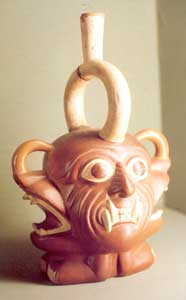
(Jar of the moche culture – south america)
Also on clerical buildings, frescos with eyes were added, or guardian statues with horrifying teeth were put to, for example, the entraces of graveyards to assure the peace of the dead.
2. Avoid demons by menacing them with gestures or weapons
Gestures to menace enemies are not only found at animals, but also at humans. Many of them were used to avoid demons.
Menacing is very effective with weapons, so many clerical figures were armed, and on many pictures, saints and people are holding spears, swords or clubs.
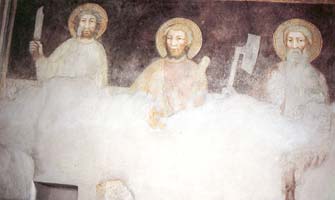
(Fresco in the choir of St. Martin – Bozen)
But also the gesture of held up hands was used to avoid evil spirits.
In Egypt, replicas of arms and hands were laid into the graves to protect the
dead.
In Europe it was a tradition of many cultures, that people who meet a funeral procession show their fore and middlefinger to hold demons back from menacing helpless dead.
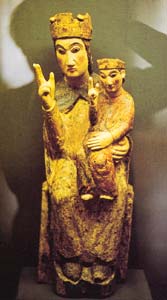
(Maria with Child – Brixen)
3. Beasts to fight demons
One of the most popular ways to avoid demons is to post beasts.
The more horrible they look the better was the chance, people thought, that the demons will fear their stone made
enemies.
Nearly every church in the middle ages was equipped with these creatures.
Snakes also were used to avoid demons, mostly painted in an aggressive pose on pots or in reliefs.
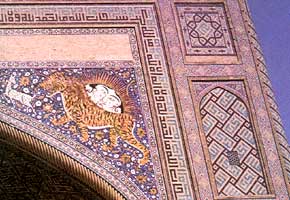
(Sir-Dar-Moschee - Samarkand)
4. Avoid demons with deformated figures
Early groups of explorers were surprised at the great number of statues showing deformated people. The science is now sure that statues, for example found in south or middle america were made to avoid demons.
The view of the freaks was ment to signalise the demons that it’s dangerous for them here.
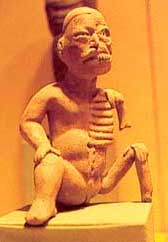
(Colima-Culture, Mexico)
Also in christian history such objects are found very often.
Figures, deformed or then shown with a visible grave sickness, such as the famous pest christ in Damüls.
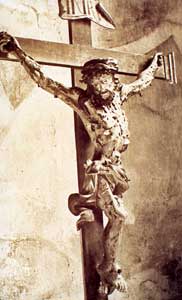
(Pest christ)
5. Determent trough nudity
Already in old greece, Plutarch is telling that lykian women undressed in front of the floods of Poseidon, which he sent to drown Lykia, and so made the floods go back ashamed.
Also the romans told that naked, mensturating women are avoiding weather demons.
In central american cultures, especially Mexico, meeting houses for men were decorated with statues of naked women to determinate demonic unfluences.
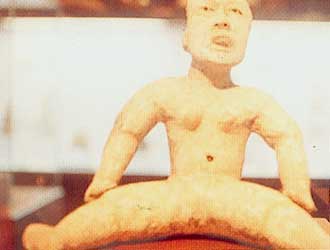
(Statue – central mexico)
Determent by pictures of naked breasts or gential organs were often accompanied by snakes, which were ment to make the pictures even stronger.
But also phallic symbols were used, for example in Japan as pillars, to protect ways and streets.
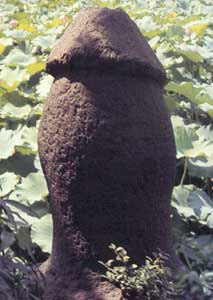
(Pillar – Tokio)
6. Determent trough crying
Because people thought demons were sensitive to noise, many cultures thought that crying and laments would avoid them.
Many cultures in africa used to interrupt funeral ceremonies with loud cries, that should avoid potential demons.
Many historians and ethnologists think that the torturing or burning of cats, that sometimes was celebrated during parties in middle ages had the same sense, avoiding demons trough the cries of the animal.
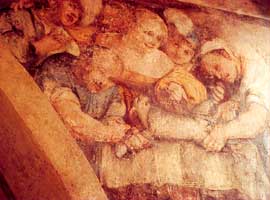
(Fresco – Trient)
Of course also bells should be named here, because the sound of a bell was ment to have the same effect.
7. Determent with knots
Knots and knotted cords were in many cultures a popular protection against demons.
Cult knot amulets in cretian-mykenian culture, different images of Bodhisattva, with the knot at his arm that looks pretty similar to the one at a dancer’s leg on a relief in the golden Dacherl in Innsbruck – all these knots were meant to protect against evil powers and spirits.
Buildings and their rooms were often decorated with beautiful knots to avoid demons from entering the building.
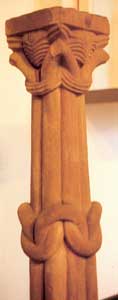
(Romanic Churchpillar)